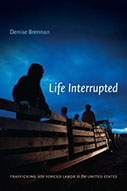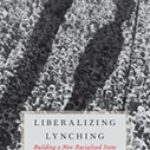Life Interrupted: Trafficking into Forced Labor in the United States

Author: Denise Brennan
Publisher: Durham, NC; Duke University Press Books, 2014. 304p.
Reviewer: Kimberly M. Pitts | May 2015
When one thinks of human trafficking, sex trafficking is what often comes to mind, particularly as the media touts sensationalized reports of women rescued from brothels. In Life Interrupted: Trafficking into Forced Labor in the United States, anthropologist Denise Brennan not only aims to set the record straight about sex trafficking, she provides an insight into the human side of trafficking by focusing on the daily lives of forced laborers, thereby de-mythologizing their experience. Referring to the resilient and resourceful men and women as formerly trafficked people, she refuses to portray them as victims. Through extensive conversations over nearly ten years with formerly trafficked individuals, advocates, attorneys and social workers, Brennan brings a wealth of knowledge and insight into the daily struggles of immigrants who have been trafficked into forced labor. While many documents of human trafficking end with a rescue, Life Interrupted is unique in that the book continues the narrative by focusing on the rebuilding process of life beyond trafficking.
The first part of the book deals with trafficking policies and exiting forced labor.
Brennan argues that anti-immigration and anti-prostitution policies have shaped trafficking policies and have been an assault on migrant and sex workers, both vulnerable populations who operate at the fringe of the legal system. Equating prostitution with trafficking and sexual slavery, the George W. Bush administration worked with the unlikely partnership of religious and feminists groups to eradicate sex sector exploitation, but in the process further marginalized and endangered the lives of sex workers while ignoring workers in forced labor. Sensationalized media reports showed stories of young women’s rescues and new advocacy organizations staffed by idealistic inexperienced people sprang up vying for federal funding and clients in their quest to end this modern form of slavery. While the Trafficking Victims Protection Act was passed in 2000 under the Clinton administration, fewer than 5,000 formerly trafficked people have received t-visas. Continuing to link trafficking and migration policies, during the first term of Obama’s administration, more than a million immigrants were deported, largely as a result of Immigration and Customs Enforcement (ICE) raids. Brennan argues that rather than risk deportation or police inquiry, immigrants forego complaints against abusive employers as they endure injustices ranging from wage theft to unsafe working conditions.
After discussing the effects of recent immigration and trafficking policies on those working in forced labor, and providing insight into the vulnerable nature of their work, the author turns to an examination of coercive work and the complexities in escaping abusive employment. Through the life histories of several women and supplementary advocacy interviews, the author explores transnational labor migration and provides insight into the reasons why people take such calculated risks in their path to becoming global workers. Through an anecdotal examination, the author demonstrates that a complex network of people, including boyfriends and family members, are involved in the trafficking process.
Brennan argues that forced labor reflects the stratification system in the country of origin. In hearing of extreme forms of abuse, such as withholding food, one is often compelled to ask what prompts the laborer to stay. The author shows that trafficked individuals, like other migrants, often remain in abusive work situations for various reasons, such as lack of access to their visa, fear of retaliation against family members in the home country,
and fear of police and deportation. The mechanisms that traffickers employ to control workers range from isolation to surveillance, indebtedness, and physical abuse. While Brennan chronicles the experience of one woman who took efforts to make a case against her employer by documenting the abuse, many workers are not aware of community resources or legal protection to help those experiencing coercive labor. Exiting forced labor can be an ambivalent experience for many people as they desire to leave the exploitative conditions in which they live, yet fear not only their traffickers, but everyone from neighbors to law enforcement.
The three chapters of the second part deal with the daily struggles of formerly trafficked people as they settle into a life beyond forced labor. Unlike other immigrants, formerly trafficked persons maneuver their resettlement with social workers and attorneys through a complex lengthy process as they wait for a t-visa and green card. Brennan points out that therapy is often pushed upon people immediately after exiting forced labor; yet many of those who were interviewed claim they were not traumatized by their experience. They assert that help securing employment and legal advice are more immediate needs than is therapy, as governmental assistance to trafficked persons rarely lasts beyond a year. The author further states that while a number of non-profit organizations have emerged over the last few years to help those who are affected by forced labor, there is only one shelter for formerly trafficked women and it is located in California.
The resettlement period is one of insecurities and possibilities. One would think that formerly trafficked immigrants would prefer to settle in communities with co-ethnics, but Brennan shows that immigrants of the same ethnicity may not be a source of strong social support, especially if the trafficker was of the same ethnicity. Formerly trafficked persons may be hesitant about sharing their experiences in forced labor with undocumented co-ethnics who are oppressed by exploitative labor, but who do not qualify for t-visas. While social isolation and fear are daily struggles of many undocumented immigrants, the author argues that formerly trafficked individuals must negotiate the resettling process without a social network of family to share the economic burdens. It is during the early period of resettlement after exiting the trafficking situation, that many formerly trafficked women are housed at domestic violence or homeless shelters and learn of others who have escaped forced labor. As their social networks grow beyond attorneys and social workers, some begin to obtain skills necessary for employment, such as learning the English language and how to drive a car, as they plan for a more permanent settlement. Living in a shelter is a daily reminder of their situational instability and securing housing on their own is cost prohibitive, thus sharing a dwelling with other immigrants is a rational option.
Through glimpses into the life experiences of formerly trafficked immigrants, the author demonstrates the difficulties of transitioning from forced labor into the world of migrant labor, replete with its own issues. While some formerly trafficked individuals are hesitant about entering the job market and mistrust those with whom they work, others use the memory and lessons learned from their exploitative experience to ensure that they do not suffer the same injustices. Having exited forced labor, they self-advocate in their new employment opportunity and some even consider work to be therapeutic. However, as migrant workers they are often relegated to seasonal, temporary or low-wage positions without medical benefits. Yet, Brennan notes that based on interviews with social workers, the idea of a good job for a formerly trafficked person often differs from what others consider to be a good job. Many prefer to work alongside co-ethnics, regardless of job type. For formerly trafficked women, the employment they attain may be the same type engaged in while they were in the trafficking situation, such as being child caregivers and domestic helpers.
Brennan acknowledges that the quotidian struggles of life after trafficking are similar to those many migrants face living in the United States. Working a low-wage job and struggling to pay rent leaves little time or money for seeking an education, yet some of the formerly trafficked women in the study were able to earn their GED and went on to become nursing assistants. Brennan does consider the bias in directing formerly trafficked women to the nursing assistant field, which is female-dominated and low-paying. Like other immigrants who live on the edge of poverty and deal with lack of medical care and nutritious food and living in violent neighborhoods, formerly trafficked individuals often must also send remittances to family members in the country of origin.
While the book demonstrates the difficulties of transcending the trafficked/formerly trafficked life, Brennan reveals that in many ways these individuals live ordinary lives. Many fall in love, get married and have children. For some, work is a place where they feel empowered as they become financially independent and valued. It is the place where they start to socialize, make friends and experience living in the United States. Some formerly trafficked people become advocates, mentors and organizers in the fight against human trafficking. The author is critical, however, of the media portrayal of human trafficking and suggests that efforts to help those who have recently escaped forced labor should focus on driver’s education and financial opportunities beyond low-wage occupations. The appendix suggests ways in which the reader can get involved in making a true effort to halt human trafficking, and it lists organizations by state that work with various immigrant groups.
As the title of the book, Life Interrupted, aptly demonstrates, trafficking is an interruption in the lives of immigrant men and women. Combining interviews with extensive research, Denise Brennan shows that living independently in a country in which one was brought for forced labor is an unimaginable challenge. While the firsthand accounts add to the narrative of human trafficking, the themes become repetitive as the book progresses, lending to a lack of organization in the second part. Despite that, this book is important to the body of human trafficking research in that it illustrates a side of trafficking that is often left out — the human side. The discussion of the claimsmaking of human trafficking as a social problem encompassing pornography and the sex industry is timely. Life Interrupted is likely to appeal to a wide audience beyond academia.
Kimberly M. Pitts, Assistant Professor of Sociology, Campbellsville University


